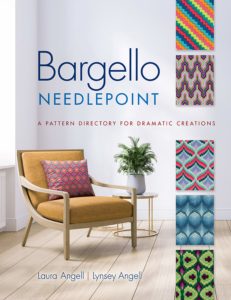
Laura Angell & Lynsey Angell, Dover, 2020, ISBN:978-0-486-8291=2, $22.95
The winners of the birthday contest are: Kathy C, Bfrom M, Susan Millen, Monica Dupre, Mary Ronan, Cheryl Roler Timko, Lee Decker, Karen, Arlene harris, and NP Jenn. Thanks to all who entered!
I waited for a very long time for this book. When it came I was tremendously disappointed. Not only does it very hew patterns, it also has unreadable charts, and incorrect advice. At the price it is and the publisher who brought it out, we have every reason to expect better.
The authors say they searched the internet with difficulty for information about Bargello, but I can’t figure out where they looked. There are plenty of free patterns an instructional sites and videos out there. I just did a quick Google search on Bargello and found videos on how to stitch Bargello as well as several sites with instructions. Angell looked, as far as I can tell at one book, Elsa William’s Bargello. At least she looked at what is probably the seminal book on Bargello, even though it has no charts.
The book follows the usual format for craft books, beginning with a discussion of materials and tools. Her you’ll find the incorrect information. First, they recommend using a hoop instead of stretcher bars. This is in spite of the fact that it wastes money because pieces of canvas have to be far larger for hoops than bars. Second, hoops will not keep canvas under good tension because canvas is too stiff to have good tension in a hoop. Finally, and most importantly, hoops will crush needlepoint when it is caught between the rings of the hoop. This cannot be corrected.
Another problem is that they blithely tell us that any DK knitting yarn can be used for Bargello. In fact, all the models use these yarns. However, my experience in trying many knitting yarns for needlepoint shows that it isn’t so easy. Some knitting yarns are too fragile to be drawn repeatedly through the canvas. Other yarns stretch too much to be used. Only experimentation can tell which will work for needlepoint of any kind. The information about yarns and threads fails, in addition, to tell about weights of yarn that will work with different mesh sizes of canvas. This would have been so easy to add.
After the section on materials, there is a section on stitches. It’s good enough and more or less correct, but calling different directions of the stitch different stitches will do a disservice to those seeking more Bargello patterns.
The patterns, which form the core of the book, are divided into four groups. The patterns, four in each section, are divided into three groups: easy, intermediate, and advanced. A final section adds patterns for borders and other projects. You did read that right the book has a total of twelve Bargello patterns. Each pattern has several color variations. But color variations are not new patterns. Occasionally a pattern is varied and does actually constitute a new pattern, but this happens only ocassionally. The final section has fourteen patterns.
Another problem is that many of the patterns are taken, name and all, from Elsa Williams’ book. I grabbed my copy of the book and looked through it. Nearly half the patterns in the main sections of the book are from Williams’ book. I know that many Bargello patterns are timeless and can’t be copyrighted, even so, I would have liked to see some acknowledgment of the source.
When a pattern has a two-page spread, one page has a large picture of the pattern stitched along with a color key. On the facing page is a chart, and pictures of the steps stitched. If the colors are significantly different, the stitches can be distinguisghed, if it is small. If the colors are close the small size of the charts makes it difficult if not impossible to distinguish stitches. One page spreads include a picture and a color charts.
Many Bargello books have difficulties having easy-to-read charts because of size. However, this can be helped if the stitch symbols are varied in color and have space between each stitch. Unhappily these are missing here.
The final section of the book is “taking Bargello further.” This has some of the most interesting work in the book. The first ten patterns do include charts. The final four do not include charts, which would have been useful.
I am very disappointed in this book and cannot recommend it. Bargello is a lovely form of needlepoint and deserves to get more attention. But this book won’t help accomplish this. If you know folks who want to learn this, buy them canvas and thread, print a good chart from the Web and teach them yourself.
About Janet M Perry
Janet Perry is the Internet's leading authority on needlepoint. She designs, teaches and writes, getting raves from her fans for her innovative techniques, extensive knowledge and generous teaching style. A leading writer of stitch guides, she blogs here and lives on an island in the northeast corner of the SF Bay with her family

Leave a Reply